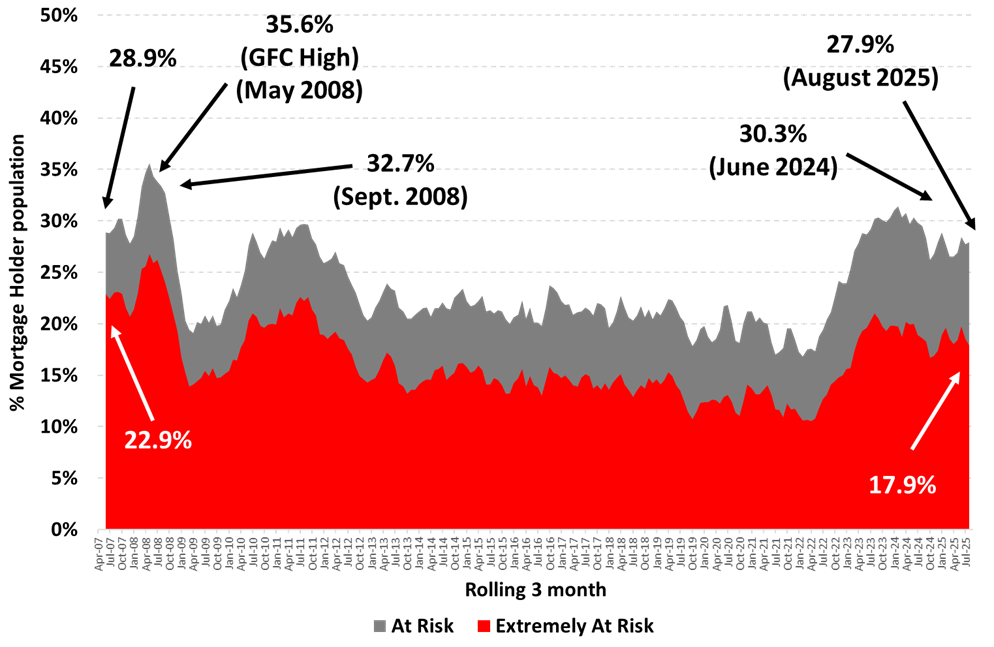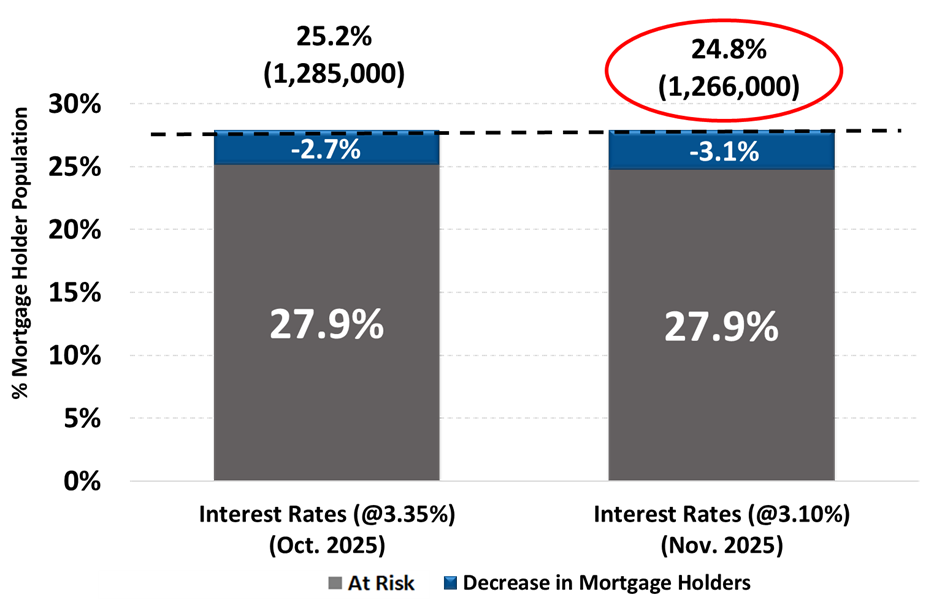Risk of mortgage stress remains high despite interest rate cut in mid-August

New research from Roy Morgan shows 27.9% of mortgage holders ‘At Risk’ of ‘mortgage stress’ in the three months to August 2025, down only 0.5% points from June 2025.
The share of mortgage holders ‘At Risk’ of ‘mortgage stress’ has been above 25% for over two-and-a-half years since February 2023, despite three interest rate cuts so far this year.
The record high of 35.6% of mortgage holders in mortgage stress was reached in mid-2008.
616,000 more ‘At Risk’ of mortgage stress three years after interest rate increases began
The number of Australians ‘At Risk’ of mortgage stress has increased by 616,000 since May 2022 when the RBA began a cycle of interest rate increases which lifted official interest rates by a total of 4.25% from 0.1% to a high of 4.35% from November 2023 until February 2025.
The number of Australians considered ‘Extremely At Risk’, is now numbered at 915,000 (17.9% of mortgage holders) which is significantly above the long-term average over the last 10 years of 14.8%.
Mortgage Stress – % of Owner-Occupied Mortgage-Holders

Source: Roy Morgan Single Source (Australia), average interviews per 3 month period April 2007 – Aug 2025, n=2,874.
Base: Australians 14+ with owner occupied home loan.
Mortgages ‘At Risk’ set to drop if the Reserve Bank cuts interest rates to 3.35% or even 3.1%
Due to the decline in inflation over the last year the Reserve Bank has now cut interest rates in February, May and again in August by a total of 0.75% to 3.6%. Roy Morgan has modelled the impact of the latest August rate cut and two additional RBA interest rate decreases this week and again in early November by a total of 0.5% to 3.1%.
In August, 27.9% of mortgage holders, 1,423,000, were considered ‘At Risk’. Looking forward, as the Reserve Bank’s latest interest rate cut flows through the economy, the share of mortgage holders ‘At Risk’ is forecast to decline in September by 1.4% points to 26.5% of mortgage holders (1,353,000, down 70,000).
If the Reserve Bank were to cut interest rates this week by 0.25% to 3.35% (to take effect from October 1, 2025), the share of mortgage holders ‘At Risk’ would drop to 25.2% in October 2025 – down 2.7% points from now and the lowest share for over two-and-a-half years since January 2023.
Looking further forward, if the Reserve Bank decides to cut interest rates by an additional 0.25% to 3.1% in early November, the share of mortgage holders ‘At Risk’ would drop to 24.8% (down 3.1% points from now) of mortgage holders (1,266,000, down 157,000 from now) by November.
Mortgage Risk projections based on an interest rate cut in September and November to 3.1%

Source: Roy Morgan Single Source (Australia), June – August 2025, n=3,253.
Base: Australians 14+ with owner occupied home loan.
How are mortgage holders considered ‘At Risk’ or ‘Extremely At Risk’ determined?
Roy Morgan considers the risk of ‘mortgage stress’ among mortgage holders in two ways:
Mortgage holders are considered ‘At Risk’[1] if their mortgage repayments are greater than a certain percentage of household income – depending on income and spending.
Mortgage holders are considered ‘Extremely at Risk’[2] if even the ‘interest only’ is over a certain proportion of household income.
Unemployment is the key factor which has the largest impact on income and mortgage stress
It is worth understanding that Roy Morgan uses a conservative forecasting model, essentially assuming all other factors apart from interest rates remain the same.
The latest Roy Morgan unemployment estimates show over one-in-five Australian workers are either unemployed or under-employed – 3,516,000 (22.0% of the workforce); (In August Australian unemployment increased by 0.8% to 11.1% with under-employment unchanged at 10.9%).
Although the Reserve Bank’s decision to cut interest rates in February, May and August have had a positive impact and helped marginally lower mortgage stress, the fact remains the greatest impact on an individual, or household’s, ability to pay the mortgage is not interest rates, it’s if they lose their job or main source of income.
Michele Levine, CEO Roy Morgan, says the Reserve Bank’s (RBA) interest rate cut in mid-August by 0.25% to 3.35% has lowered mortgage stress, but further cuts are required to lower mortgage stress back to the levels of two-three years ago:

“The latest Roy Morgan data shows 1,423,000 Australians ‘At Risk’ of mortgage stress in August 2025 equivalent to 27.9% of mortgage holders – down 0.5% points since June 2025.
“The RBA cut interest rates in February 2025, May 2025, and most recently in mid-August 2025, by a total of 0.75% to 3.6%. If the RBA cuts interest rates this week, or in early November, by a further 0.25% to 3.35%, the share of mortgage holders ‘At Risk’ will drop to 25.2% – the lowest for over two-and-a-half years since January 2023.
“However, as we have previously highlighted, although the short-term impact of reducing interest rates is an immediate reduction in mortgage stress, there are counter-vailing factors that mean it can lead to further stress down the road.
“As general interest rates are lowered, new buyers entering the market are able to borrow more money for larger loans to buy the best house they can afford at that time, and this, in turn, leads to a subsequent increase in mortgage stress due to the larger size of the average loan.
“Finally, it is important to appreciate that interest rates are only one of the variables that determines whether a mortgage holder is considered ‘At Risk’ – the largest impact on whether a borrower falls into the ‘At Risk’ category is related to household income – which is directly related to employment.
“The employment market has been strong over the last three years (the latest Roy Morgan estimates show nearly 1 million new jobs created since May 2022) and this has provided support to household incomes which have helped to moderate levels of mortgage stress over the last year.”
These are the latest findings from Roy Morgan’s Single Source Survey, based on in-depth interviews conducted with over 60,000 Australians each year including over 10,000 owner-occupied mortgage-holders.
To learn more about Roy Morgan’s mortgage data, call (+61) (3) 9224 5309 or email askroymorgan@roymorgan.com. Please click on this link to the Roy Morgan Online Store.
[1] "At Risk" is based on those paying more than a certain proportion of their after-tax household income (25% to 45% depending on income and spending) into their home loan, based on the appropriate Standard Variable Rate reported by the RBA and the amount they initially borrowed.
[2] "Extremely at Risk" is also based on those paying more than a certain proportion of their after-tax household income (25% to 45% depending on income and spending) into their home loan, based on the Standard Variable Rate set by the RBA and the amount now outstanding on their home loan.
Margin of Error
The margin of error to be allowed for in any estimate depends mainly on the number of interviews on which it is based. Margin of error gives indications of the likely range within which estimates would be 95% likely to fall, expressed as the number of percentage points above or below the actual estimate. Allowance for design effects (such as stratification and weighting) should be made as appropriate.
| Sample Size | Percentage Estimate |
| 40% – 60% | 25% or 75% | 10% or 90% | 5% or 95% | |
| 1,000 | ±3.0 | ±2.7 | ±1.9 | ±1.3 |
| 5,000 | ±1.4 | ±1.2 | ±0.8 | ±0.6 |
| 7,500 | ±1.1 | ±1.0 | ±0.7 | ±0.5 |
| 10,000 | ±1.0 | ±0.9 | ±0.6 | ±0.4 |
| 20,000 | ±0.7 | ±0.6 | ±0.4 | ±0.3 |
| 50,000 | ±0.4 | ±0.4 | ±0.3 | ±0.2 |



